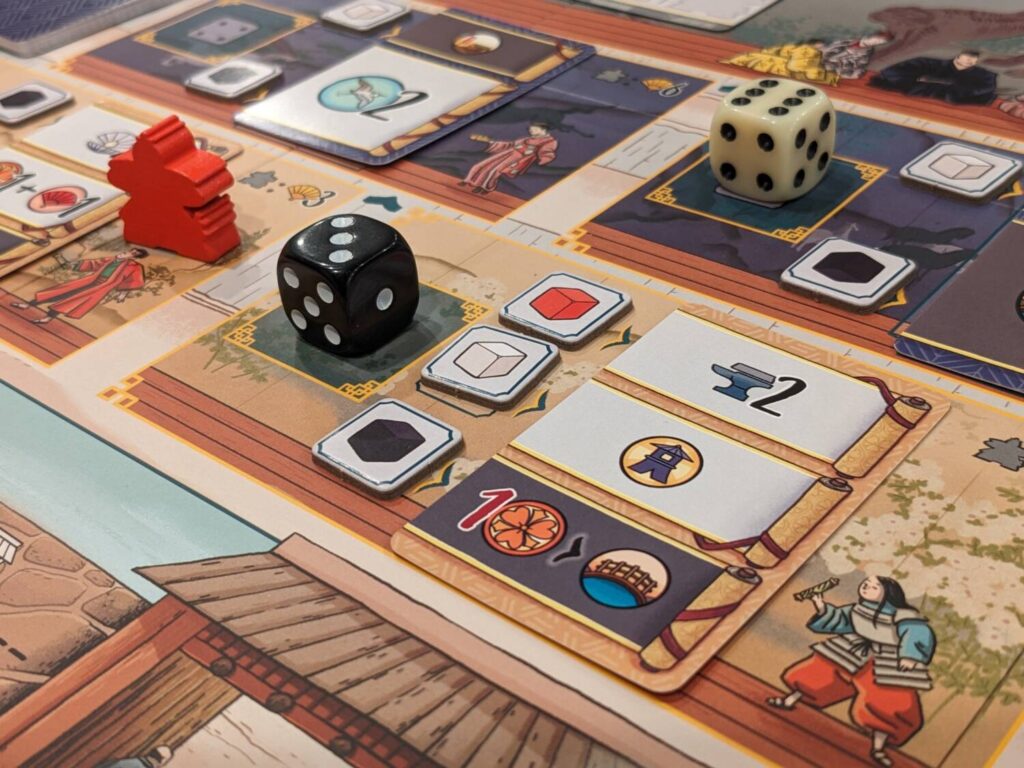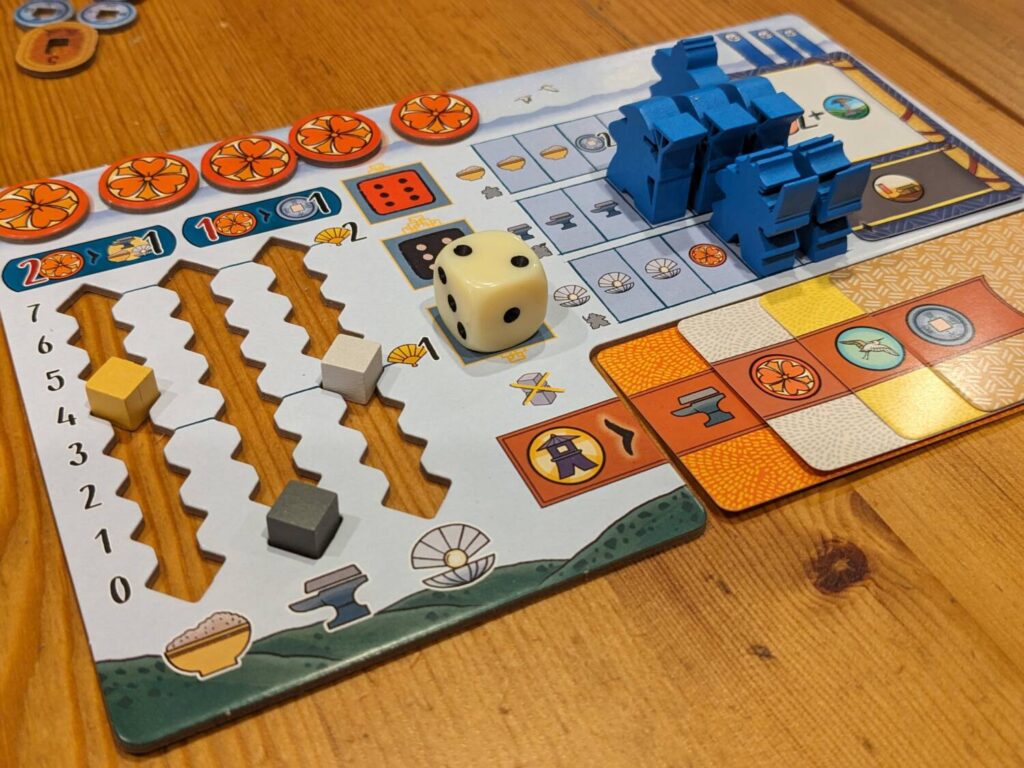Disclosure: Meeple Mountain received a free copy of this product in exchange for an honest, unbiased review. This review is not intended to be an endorsement.
“It’s The White Castle, not White Castle.”
That distinction is important. On one hand, you’ve got White Castle, a burger joint that might be one of the defining experiences of my childhood, an iconic fast food institution, or a funny Kal Penn movie series. (This is also not to be confused with “Whitechapel”, which one player made when wondering if this was like “the British cop show.”)
On the other hand, you’ve got The White Castle, a new tabletop “medium-box” experience (my term for a somewhat-heavier game in a small box) designed by Israel Cendrero and Sheila Santos, the duo known as Llama Dice. Llama Dice designed my favorite game released in 2020, The Red Cathedral.
The White Castle, published by Devir (The Red Cathedral, as well as 3 Ring Circus, Mille Fiori, and a host of other similar-weight Eurogame productions), has players trying to advance the standing of their clan with the daimyo of the Himeji Castle in the Japan of the distant past.
The similarities between The White Castle and The Red Cathedral are many. Both games share a similar weight in strategic decision-making, dice that play a prominent role in the gameplay, a score track that loops at the 40-point mark, and a box that uses every millimeter of its space to hold stuff for an MSRP of approximately $35.
One other thing: both games are really good. Each of my five plays (two solo, and one each at two, three, and four players) has been increasingly interesting, with fun combos, a transparent scoring mechanic, and a simple-to-learn, difficult-to-master hook that has me excited to continue exploring how to maximize my score.
My only point of contention (besides the title, of course) after five plays: is The White Castle too short?

A Bridge Full of Dice
The White Castle takes place over three rounds, with each player taking just three turns per round. Just sharing this fact with other players has led to looks of confusion when doing the 15-minute teach.
“You’re saying this entire game is only nine turns long?”
The White Castle looks more complex, in terms of its actions. Then the teach wraps up, and players seem to embrace that this game is meant to be a shorter experience.
A series of six-sided dice, in three colors (coral, black, white), are rolled to start a round. The dice pool includes one of each color die per player, with an extra die in each color to offer more choices and trigger end-of-round bonuses.
On a turn, a player selects one of the dice at either end of a dice bridge, a cardboard standee that has become one of my favorite components of 2023 despite being totally unnecessary (the game’s instructions indicate that you can use these dice bridges, or just use the pre-printed space on the board to place the dice). Like the equally unnecessary cardboard rocket/tile holder in Devir’s LUNA Capital, I love that the dice bridges are here. The bridges store well in the box, even when they jostle in that tight space.
A selected die must be placed in one of the game’s action selection areas. Most of these placement areas are restrictive—dice can only be activated in areas of the board aligned with tokens matching the die color. These dice placement spots are further limited by the number of pips on the space. Let’s say the space has three pips. If you place a five-pip die there, you’ll receive two coins before taking your action (five minus three is positive two, meaning a benefit). Place a two-pip die there, and you’ll have to PAY a coin to use that action (two minus three is negative one, meaning a cost).

The actions are standard Euro fare—take resources like food or mother-of-pearl, move up on a turn order track that doubles as a path to boost your end-game score, earn a few coins. You might instead take one of the game’s three main actions, which include moving meeples from your player board to activate Gardener cards or training your soldiers by taking the Warrior action. The third action feels like the heart of The White Castle, and that’s the Courtier action.
The Courtier action provides a player with a chance to take one of the actions below, up to two times (and these could be split):
- Pay two coins to send a Courtier meeple from your player board to the gates of the castle, and/or
- Pay 2/5 mother-of-pearl to move a Courtier already at the castle up 1/2 levels. This boosts the value of that Courtier at the end of the game, but it also lets a player take a card from one of the rooms of the castle for an immediate bonus as well as adding that card to the player’s board.
This last action boosts the overall income a player receives any time they take an action that triggers a Lantern Reward. A small tableau of cards sits at the bottom of each player’s board, showing an icon for a resource, a coin, points, or moving up on the Influence track to seed player order. This tableau grows each time a card is added from the castle.
The Lantern Reward pays out when a player takes a die on the left-hand side of a dice bridge, through card actions, or via other means during play. And that Lantern Reward action gets juicier and juicier all game long, pushing players to find ways to take other actions that also include the Lantern icon. The White Castle doesn’t have a lot of engine building, but the Lantern Rewards help light that path for the Eurogame lover in all of us. (Yes, all of us.)
At the end of rounds one and two, players can get bonuses from their gardeners if there are any dice left on the bridge above their gardener’s card position. After three rounds, scores are tallied from the position of courtiers, warriors (only if a player also has courtiers inside the castle), gardeners, leftover resources, and the final position on the Initiative track.

Oh, There Are Combos? Then We’re All Set
The White Castle’s dice mechanic makes the choice of a die on each turn pretty interesting. And some of the three main actions (tied to placing meeples onto the main board) trigger additional main actions, so each of my games has seen players execute 2-3 combo-rich turns per player. Turns like these make people feel good about themselves, even on a path to defeat.
The game’s nine turns (I mean, again, NINE TURNS!!!) push everyone to make efficient choices, but the way Llama Dice set up the dice actions, choices become limited very fast. I love it.
Dice placement spots are tight. In a three or four-player game, players can stack dice in a location to take an action (the same rule applies about the number of pips covering another die, and only one die can be placed on any other die during a round). Even with that flexibility, you only have so many places to use a die, and the die’s color limits what can be done in each space. Combine this with the money that you’ll need to take certain actions with low pip totals, and sometimes turns feel like a real pickle…what can I really do with this single coin, one Daimyo seal, and limited resources?
One action on the board, the Well, serves as a bailout option for a player low on cash and resources. But going there also makes one feel like they may be wasting a turn, and when you only get nine turns, even that choice becomes interesting. (Luckily, the Well action occasionally appears on the cards that align with the actions in each level of the castle, so you may find ways to get the benefits of the Well while still taking a more meaningful turn.)
Thanks to its very approachable rule set, The White Castle feels like a lighter game. I taught this game to my wife in a little over ten minutes, then our two-player game took 35 minutes. But it was a pretty rich 35 minutes, in a game that ended with a score of 44-42. The first round felt like a resource-gathering round, then we each had six turns over the final two rounds to turn those resources into something interesting.

The way that two-player game developed felt good; both my wife and I had two pretty sweet turns each, including one where I took a Gardener action that let me spend three coins to take a Warrior action, which then got me a bonus plus a chance to take another Gardener action. And the combo didn’t take long to play out.
As much as I love Tiletum (and I DO love Tiletum), some of those turns can take 5-7 minutes. In The White Castle, even the turns that have combos still buzz by in 2-3 minutes because of the way you can set up a turn. Sometimes, you know exactly what you want to do, and there are enough dice of a specific value or color that you’ll be able to execute something juicy, even if it may cost you a coin or two more than you’d like.
The Courtier action feels like the most consequential to gameplay; you really can’t ignore that area of the board. (The game IS called The White Castle, after all.) The warriors don’t even score unless there are courtiers inside the castle, so you shouldn’t even be placing warriors unless you know that you will eventually place courtiers. The Gardener action provides a chance for end-of-round income, but only after rounds one and two; in the third round, players typically hunt out the Gardener action for end-game points and a placement bonus that could help in the final turn or two.
That has led me to begin pushing hard on gathering mother-of-pearl, the resource that allows players to move courtiers into the castle and up the social ranks into the second (six points) and third (10 points) levels of the castle, which score a lot more points than courtiers left at the castle gates (one point) or on the first floor of the castle (three points).
Strategy aside, turn-to-turn actions just fly by, with each being a short-but-worthy consideration. In this way, The White Castle and The Red Cathedral really fire me up because of how many fun decisions I get to make each game.

My High Expectations Have Been Met
The White Castle is really good. It is perfect for my gaming inclinations—I like dice, interesting decisions, solid production, easy-to-teach rules, clear scoring mechanisms, and a playtime that landed in the 35-to-75-minute range across my plays.
The game still feels a little too short…but I’ve accepted that the length is just right. My main issue with the short length: every turn matters. Players will often play their first 2-3 turns (so, basically, the first round) like they have more plenty of time to get things rolling. Now that I have a few plays under my belt, I treat every turn like it is vital. Instead of only gathering resources to spend on other things later, I use my starting resources to take a main action (Gardener, Warrior, Courtier) amongst my first round turns.
That change—turning The White Castle into a go-for-broke action movie where I’m the star—has only increased my interest in seeing how each game will play out as I try to squeeze the most juice out of every turn. The variable setup also increases replayability. The different cards in each castle room, mixed with the dice colors that will trigger those actions in each game, make for such a rich moment on a turn. There are maybe ten different cards in the Daimyo deck, used for benefits in the top tier of the castle. This means that the third-level castle room has different bonuses in almost every game.
Just the rolled dice pool affects how rounds play out; the collective groans when a poor roll means everyone is working with low dice in a given color makes me laugh. This is another factor that guarantees each play will look different.
The White Castle isn’t perfect. I had some questions about how some of the bonuses work (and I’ve reached out to Devir to clarify a couple questions that aren’t clear in the rules). The red fan icon is meant to signify clan points (VPs), but on the board, that same fan is yellow, not red. The various meeples on your player board will shift during play, so there’s a light amount of “fiddly” to the components. This is important when you are trying to math out how many resources you’ll get by using your player board’s action spaces.
Another issue: the color of the castle rooms made understanding which dice could be activated a bit confusing for a few players. While there are tokens placed during setup that show which color dice can be placed in a room to take certain actions, I had to clear up some confusion around the fact that the second level of the castle (dark, almost black rooms) wasn’t only limited to the use of black dice. Or, that any number of courtiers can advance to the top level of the castle, not just the first three (because the Daimyo card bonuses are only available to the first three courtiers that reach the top).
In terms of player count, I like The White Castle quite a bit at two or three players. My final play was with the full four-player count; at four, with even one player who takes longer turns, some players might find themselves with a bit too much downtime. Even that play was relatively short—after the teach, 75 minutes—but on at least two of our turns, there was the inevitable “who’s turn is it?” moment where we noticed that one player was taking longer than expected.
Otherwise, I had a blast with my plays. The combos, the tension, the physical production, the variability, the dice bridges…The White Castle is legit. Llama Dice has done it again, and Devir is on a tear right now. Looking forward to the 2024 catalog!












I have not played (or seen, if I am honest) either The Red Cathedral or The White Castle. From your review, I think this is a situation where I will need to add both of these to my very growing collection of board games!
Although my wife and I have moved closer to our best friends (we moved from Iowa to Maryland), most physical board games we play are still limited to us as the two-players. The fact that these games are quick, interesting, and filled with decision space in a two-player confrontation means that these are two games likely to get us to the table ready to challenge each other and ourselves once again!
Thanks for another wonderful review. Keep up the great work.
Based on this review and the MM review of The Red Cathedral, I have picked both of these games up. Looking forward to diving into them!
Thanks as always!
Both games are great! Enjoy them, David!